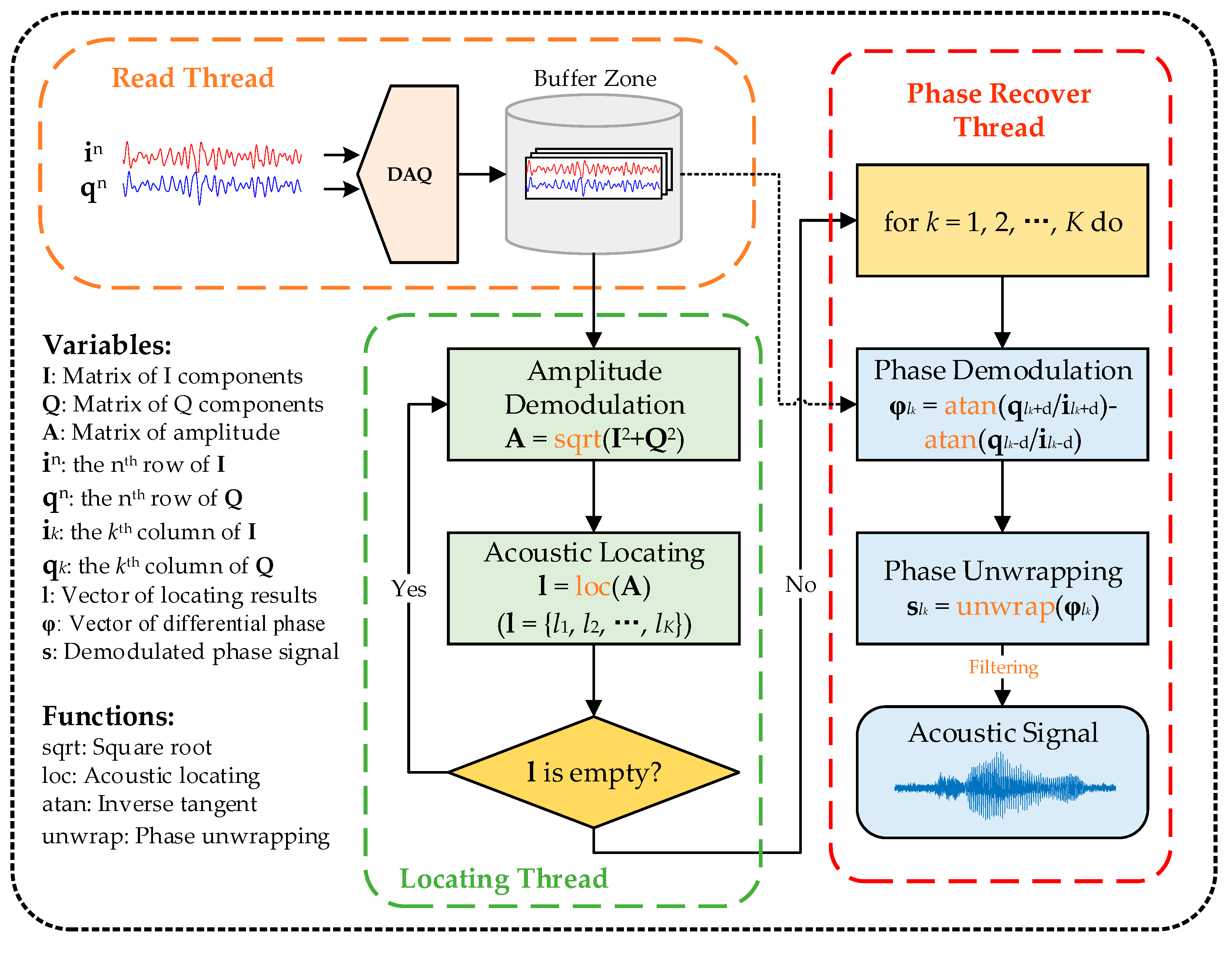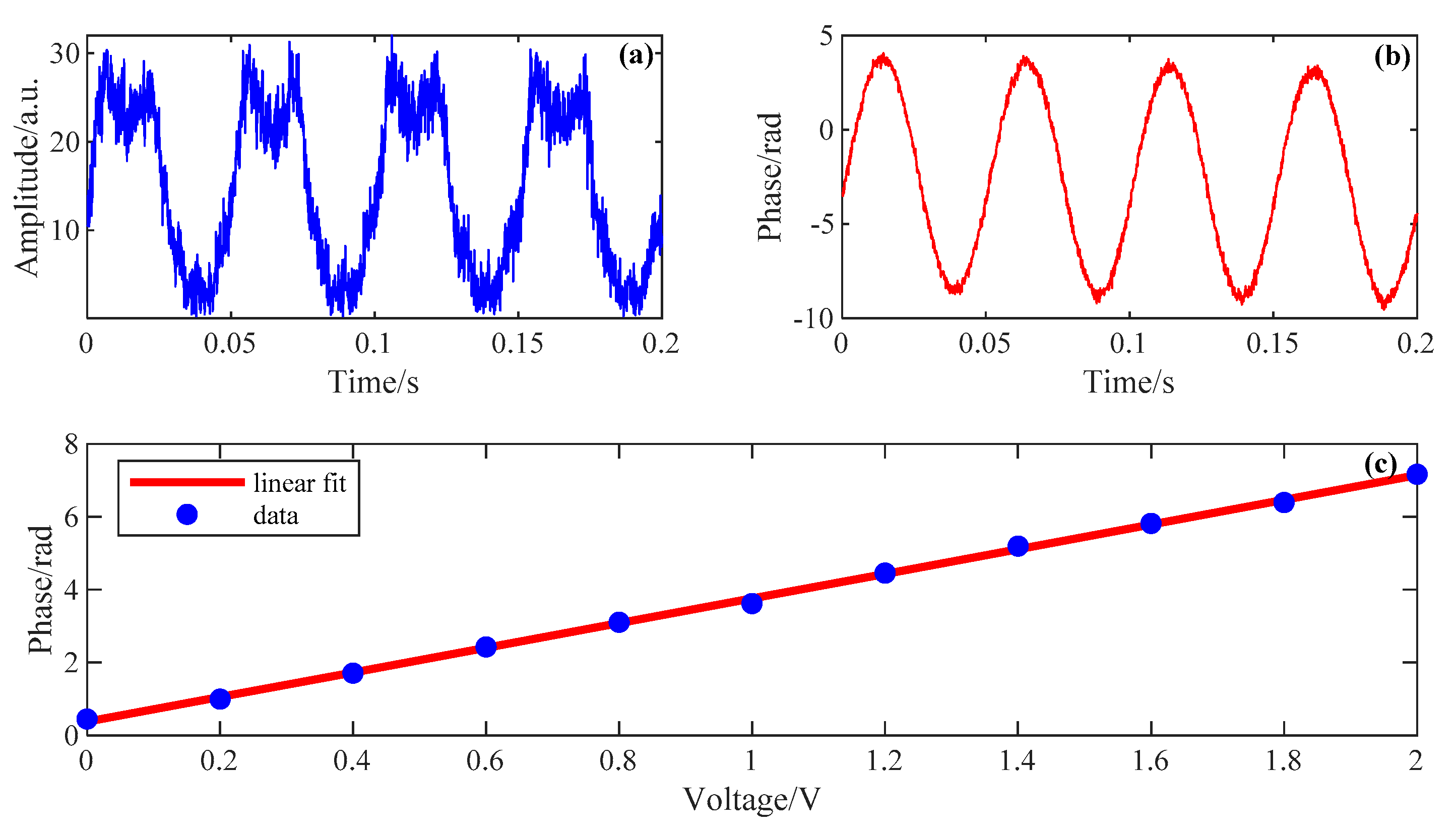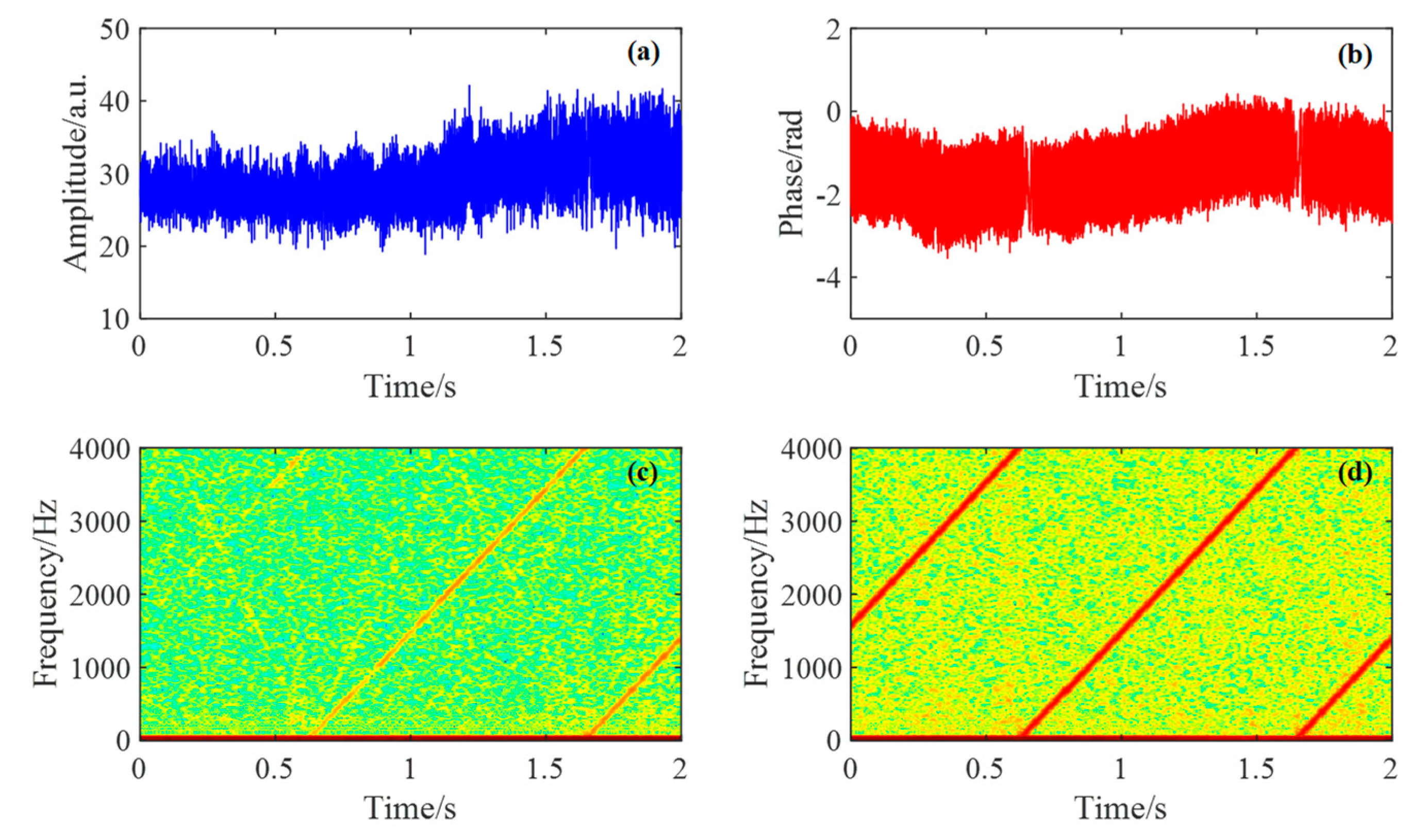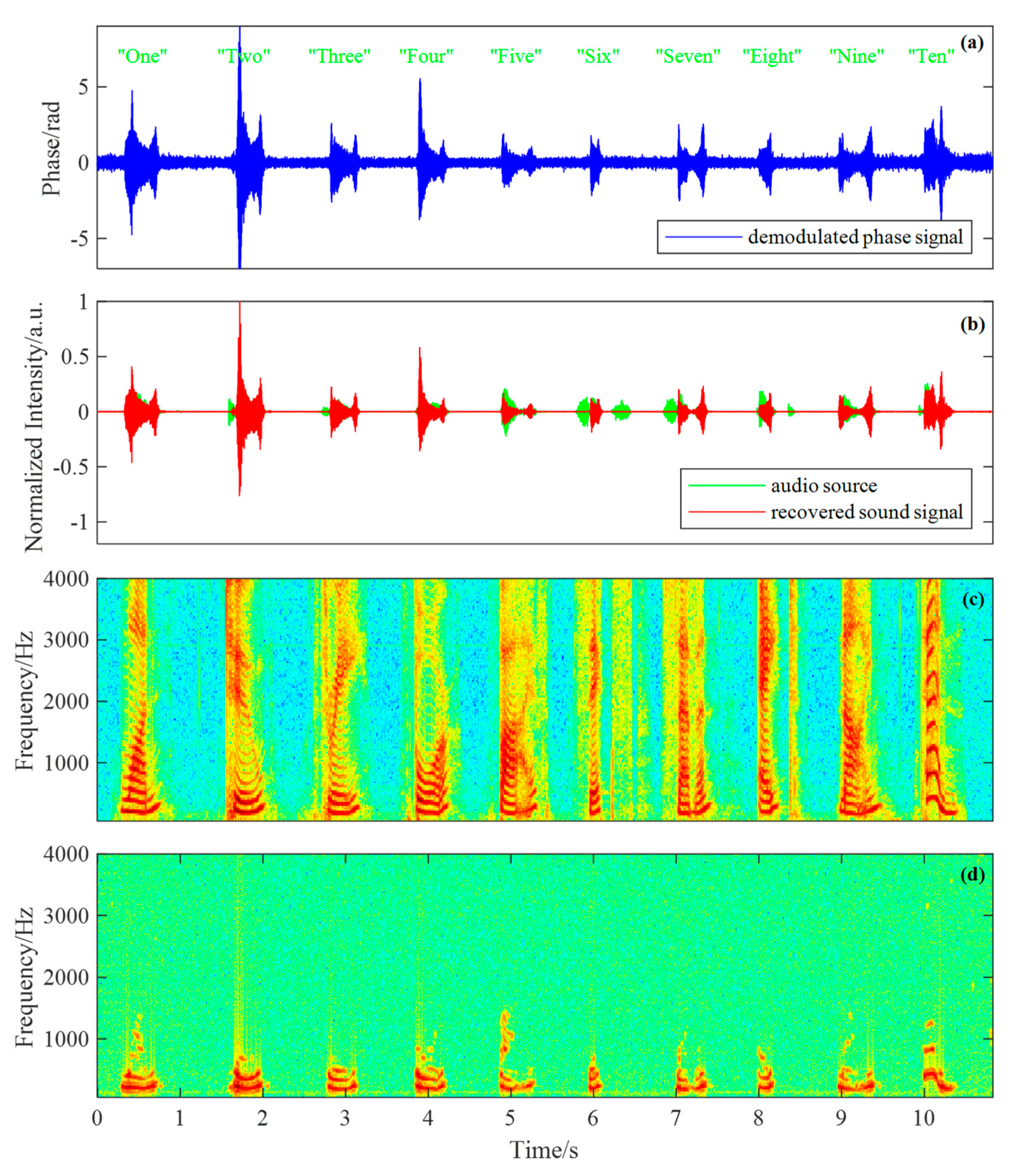Low Computational Cost Distributed Acoustic Sensing Using Analog I/Q Demodulation
Abstract
:1. Introduction
2. Configuration of Proposed System
2.1. Coherent Φ-OTDR
2.2. Analog I/Q Demodulation Module
2.3. Data Processing
2.4. Computational Cost Improvement
3. Experimental Results
3.1. Experimental Setup
3.2. Results of Event Localization
3.3. Results of PZT Vibration
3.4. Results of Sound Detection
4. Conclusions
Supplementary Materials
Author Contributions
Funding
Conflicts of Interest
References
- Juarez, J.C.; Taylor, H.F. Distributed fiber optic intrusion sensor system. J. Lightware Technol. 2005, 23, 2081–2087. [Google Scholar] [CrossRef]
- Juarez, J.C.; Taylor, H.F. Field test of a distributed fiber-optic intrusion sensor system for long perimeters. Appl. Opt. 2007, 46, 1968–1971. [Google Scholar] [CrossRef] [PubMed]
- Martins, H.F.; Martin-Lopez, S.; Corredera, P.; Filograno, M.L.; Frazao, O.; Gonzalez-Herraez, M. Coherent noise reduction in high visibility phase-sensitive optical time domain reflectometer for distributed sensing of ultrasonic waves. J. Lightware Technol. 2013, 31, 3631–3637. [Google Scholar] [CrossRef]
- Peng, F.; Wu, H.; Jia, X.H.; Rao, Y.J.; Wang, Z.N.; Peng, Z.P. Ultra-long high-sensitivity Φ-OTDR for high spatial resolution intrusion detection of pipelines. Opt. Exp. 2014, 22, 13804–13810. [Google Scholar] [CrossRef] [PubMed]
- Stajanca, P.; Chruscicki, S.; Homann, T.; Seifert, S.; Schmidt, D.; Habib, A. Detection of leak-induced pipeline vibrations using fiber-optic distributed acoustic sensing. Sensors 2018, 18, 2841. [Google Scholar] [CrossRef]
- Tejedor, J.; Macias-Guarasa, J.; Martins, H.; Piote, D.; Pastor-Graells, J.; Martin-Lopez, S.; Corredera, P.; Gonzalez-Herraez, M. a novel fiber optic based surveillance system for prevention of pipeline integrity threats. Sensors 2017, 17, 355. [Google Scholar] [CrossRef]
- Tejedor, J.; Macias-Guarasa, J.; Martins, H.F.; Pastor-Graells, J.; Martín-López, S.; Guillén, P.C.; Pauw, G.D.; Smet, F.D.; Postvoll, W.; Ahlen, C.H.; et al. Real field deployment of a smart fiber-optic surveillance system for pipeline integrity threat detection: architectural issues and blind field test results. J. Lightware Technol. 2018, 36, 1052–1062. [Google Scholar] [CrossRef]
- Tejedor, J.; Martins, H.F.; Piote, D.; Macias-Guarasa, J.; Pastor-Graells, J.; Martin-Lopez, S.; Guillén, P.C.; Smet, F.D.; Postvoll, W.; González-Herráez, M. Toward prevention of pipeline integrity threats using a smart fiber-optic surveillance system. J. Lightware Technol. 2016, 34, 4445–4453. [Google Scholar] [CrossRef]
- Sha, Z.; Feng, H.; Zeng, Z. Phase demodulation method in phase-sensitive OTDR without coherent detection. Opt. Exp. 2017, 25, 4831. [Google Scholar] [CrossRef]
- Posey, R.; Johnson, G.A.; Vohra, S.T. Strain sensing based on coherent Rayleigh scattering in an optical fibre. Electron. Lett. 2000, 36, 1688–1689. [Google Scholar] [CrossRef]
- Masoudi, A.; Belal, M.; Newson, T.P. A distributed optical fibre dynamic strain sensor based on phase-OTDR. Meas. Sci. Technol. 2013, 24, 085204. [Google Scholar] [CrossRef]
- Masoudi, A.; Newson, T.P. High spatial resolution distributed optical fiber dynamic strain sensor with enhanced frequency and strain resolution. Opt. Lett. 2017, 42, 290–293. [Google Scholar] [CrossRef] [PubMed]
- Wang, C.; Wang, C.; Shang, Y.; Liu, X.; Peng, G. Distributed acoustic mapping based on interferometry of phase optical time-domain reflectometry. Opt. Commun. 2015, 346, 172–177. [Google Scholar] [CrossRef]
- Fang, G.; Xu, T.; Feng, S.; Li, F. Phase-sensitive optical time domain reflectometer based on phase-generated carrier algorithm. J. Lightware Technol. 2015, 33, 2811–2816. [Google Scholar] [CrossRef]
- Shang, Y.; Yang, Y.; Wang, C.; Liu, X.; Wang, C.; Peng, G. Optical fiber distributed acoustic sensing based on the self-interference of Rayleigh backscattering. Measurement 2016, 79, 222–227. [Google Scholar] [CrossRef]
- Ying, S.; Yuan-Hong, Y.; Chen, W.; Xiao-Hui, L.; Chang, W.; Gang-Ding, P. Study on demodulated signal distribution and acoustic pressure phase sensitivity of a self-interfered distributed acoustic sensing system. Meas. Sci. Technol. 2016, 27, 065201. [Google Scholar]
- Wang, Z.; Zhang, L.; Wang, S.; Xue, N.; Peng, F.; Fan, M.; Sun, W.; Qian, X.; Rao, J.; Rao, Y. Coherent Φ-OTDR based on I/Q demodulation and homodyne detection. Opt. Exp. 2016, 24, 853–858. [Google Scholar] [CrossRef]
- Fu, Y.; Xue, N.; Wang, Z.; Zhang, B.; Xiong, J.; Rao, Y. Impact of I/Q amplitude imbalance on coherent Φ Phi Φ-OTDR. J. Lightware Technol. 2018, 36, 1069–1075. [Google Scholar] [CrossRef]
- Xue, N.; Fu, Y.; Lu, C.; Xiong, J.; Yang, L.; Wang, Z. Characterization and compensation of phase offset in Φ-OTDR with heterodyne detection. J. Lightware Technol. 2018, 36, 5481–5487. [Google Scholar] [CrossRef]
- Pan, Z.; Liang, K.; Ye, Q.; Cai, H.; Qu, R.; Fang, Z. Phase-sensitive OTDR system based on digital coherent detection. In Proceedings of the SPIE/OSA/IEEE Asia Communications and Photonics, Shanghai, China, 13–16 November 2011; p. 6. [Google Scholar]
- Tu, G.; Zhang, X.; Zhang, Y.; Zhu, F.; Xia, L.; Nakarmi, B. The development of an Φ-OTDR system for quantitative vibration measurement. IEEE Photon. Technol. Lett. 2015, 27, 1349–1352. [Google Scholar] [CrossRef]
- Dong, Y.; Chen, X.; Liu, E.; Fu, C.; Zhang, H.; Lu, Z. Quantitative measurement of dynamic nanostrain based on a phase-sensitive optical time domain reflectometer. Appl. Opt. 2016, 55, 7810. [Google Scholar] [CrossRef] [PubMed]
- Yang, G.; Fan, X.; Wang, S.; Wang, B.; Liu, Q.; He, Z. Long-range distributed vibration sensing based on phase extraction from phase-sensitive OTDR. IEEE Photon. J. 2016, 8, 1–12. [Google Scholar] [CrossRef]
- Pang, F.; He, M.; Liu, H.; Mei, X.; Tao, J.; Zhang, T.; Zhang, X.; Chen, N.; Wang, T. A fading-discrimination method for distributed vibration sensor using coherent detection of Φ-OTDR. IEEE Photon. Technol. Lett. 2016, 28, 2752–2755. [Google Scholar] [CrossRef]
- Tu, G.; Yu, B.; Zhen, S.; Qian, K.; Zhang, X. Enhancement of signal identification and extraction in a Φ-OTDR vibration sensor. IEEE Photon. J. 2017, 9, 1–10. [Google Scholar] [CrossRef]
- Liu, H.; Pang, F.; Lv, L.; Mei, X.; Song, Y.; Chen, J.; Wang, T. True phase measurement of distributed vibration sensors based on heterodyne Φ varphi $-OTDR. IEEE Photon. J. 2018, 10, 1–9. [Google Scholar] [CrossRef]
- Zhong, Z.; Wang, F.; Zhang, X. Event discrimination using phase correlation in Φ-OTDR system based on coherent detection. IEEE Photon. J. 2018, 10, 1–8. [Google Scholar] [CrossRef]
- Jiang, F.; Li, H.; Zhang, Z.; Hu, Z.; Hu, Y.; Zhang, Y.; Zhang, X. Undersampling for fiber distributed acoustic sensing based on coherent phase-OTDR. Opt. Lett. 2019, 44, 911–914. [Google Scholar] [CrossRef]
- Wu, Y.; Gan, J.; Li, Q.; Zhang, Z.; Heng, X.; Yang, Z. Distributed fiber voice sensor based on phase-sensitive optical time-domain reflectometry. IEEE Photon. J. 2015, 7, 1–10. [Google Scholar] [CrossRef]
- Jiang, F.; Li, H.; Zhang, Z.; Zhang, Y.; Zhang, X. Localization and discrimination of the perturbation signals in fiber distributed acoustic sensing systems using spatial average kurtosis. Sensors 2018, 18, 2839. [Google Scholar] [CrossRef]
- Lu, Y.; Zhu, T.; Chen, L.; Bao, X. Distributed vibration sensor based on coherent detection of phase-OTDR. J. Lightware Technol. 2010, 28, 3243–3249. [Google Scholar]
- Boll, S. Suppression of acoustic noise in speech using spectral subtraction. IEEE Trans. Acoust. Speech Signal Process. 1979, 27, 113–120. [Google Scholar] [CrossRef]









© 2019 by the authors. Licensee MDPI, Basel, Switzerland. This article is an open access article distributed under the terms and conditions of the Creative Commons Attribution (CC BY) license (http://creativecommons.org/licenses/by/4.0/).
Share and Cite
Jiang, F.; Lu, Z.; Cai, F.; Li, H.; Zhang, Z.; Zhang, Y.; Zhang, X. Low Computational Cost Distributed Acoustic Sensing Using Analog I/Q Demodulation. Sensors 2019, 19, 3753. https://doi.org/10.3390/s19173753
Jiang F, Lu Z, Cai F, Li H, Zhang Z, Zhang Y, Zhang X. Low Computational Cost Distributed Acoustic Sensing Using Analog I/Q Demodulation. Sensors. 2019; 19(17):3753. https://doi.org/10.3390/s19173753
Chicago/Turabian StyleJiang, Fei, Zixiao Lu, Feida Cai, Honglang Li, Zhenhai Zhang, Yixin Zhang, and Xuping Zhang. 2019. "Low Computational Cost Distributed Acoustic Sensing Using Analog I/Q Demodulation" Sensors 19, no. 17: 3753. https://doi.org/10.3390/s19173753
APA StyleJiang, F., Lu, Z., Cai, F., Li, H., Zhang, Z., Zhang, Y., & Zhang, X. (2019). Low Computational Cost Distributed Acoustic Sensing Using Analog I/Q Demodulation. Sensors, 19(17), 3753. https://doi.org/10.3390/s19173753




